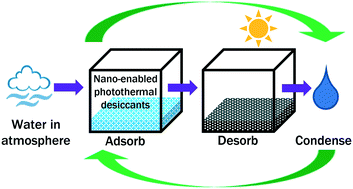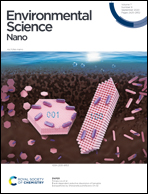Sunlight-driven atmospheric water capture capacity is enhanced by nano-enabled photothermal desiccants†
Abstract
Atmospheric water capture (AWC) is an alternative method of localized water production whereby water vapor is removed from air to produce drinking water. The most advantageous AWC applications are for developing solar energy driven, off-grid water sources. Solid phase silica gel (SiO2) desiccant materials can adsorb and concentrate water vapor in many relative humidity (RH) (20–100%) and temperature (20–40 °C) conditions. Generating sufficient solar thermal heat to release all of the sorbed water vapor from the desiccant bed can take many hours of sunlight, which limits the AWC system to just one adsorption–desorption–condensation cycle per day. In this work, we applied solar-light active photothermal nanomaterials (gold cubes and rods, carbon black) on SiO2 desiccant surfaces with the aim of providing localized heat sources, thereby rapidly increasing desiccant surface temperature, improving kinetics and totality of water vapor desorption, and allowing additional AWC cycles per day. Desiccants were tested for adsorption at 40%, 60%, and 80% RH and desorption under 1-Sun simulated solar irradiation. In the optimal use-case scenario, 5 wt% carbon black coated SiO2 could cycle through >10 adsorption–desorption phases per day to produce 0.47 g H2O per g desiccant/12 hours (2 L m−2) at 40% RH. By innovating material and AWC system design to operate over multiple atmospheric water harvesting cycles per day, we showed that nano-enabled photothermal desiccants can be applied in semi-arid climates to produce 10-fold more water than one standard cycle using a bare SiO2 desiccant.

- This article is part of the themed collections: Nanomaterials in air and Nanomaterial applications in water


 Please wait while we load your content...
Please wait while we load your content...
